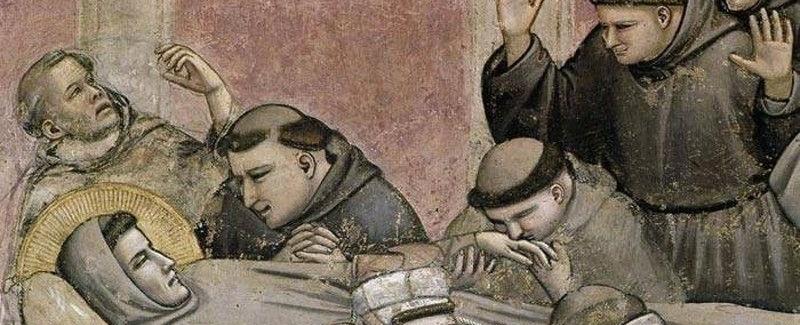Transitus of Saint Francis: Welcoming Sister Death

795 years ago this evening, October 3, 1226, Francis of Assisi passed from this life into the fullness of the Divine.
Yielding up the spirit of life
His health had been sharply declining, and several months earlier, he had asked to come home to Assisi. According to St. Bonaventure’s account, Francis was being nursed in the bishop’s residence in the city, but aware that his death was imminent, “he asked to be carried to St. Mary of the Portiuncula so that he might yield up the spirit of life where he had received the spirit of grace.”
 Saint Clare nursing Saint Francis and seeing the wounds of the Stigmata. Historically speaking, this moving image depicts something that "might have happened"—we know that when Francis was very ill and depressed, he went to San Damiano where he was nursed by the Poor Sisters, but we also know that he always took care to conceal the wounds while he was alive. What is certain, though, is the deeper meaning: the vessel of water Clare is using is engraved with a phrase from the Gospel passage that Francis asked to be read at his death: the Washing of the Feet at the Last Supper: "I have given you an example that you also should do." (Artist Karen Schmidt, Franciscan Renewal Center, Scottsdale, Arizona)
Saint Clare nursing Saint Francis and seeing the wounds of the Stigmata. Historically speaking, this moving image depicts something that "might have happened"—we know that when Francis was very ill and depressed, he went to San Damiano where he was nursed by the Poor Sisters, but we also know that he always took care to conceal the wounds while he was alive. What is certain, though, is the deeper meaning: the vessel of water Clare is using is engraved with a phrase from the Gospel passage that Francis asked to be read at his death: the Washing of the Feet at the Last Supper: "I have given you an example that you also should do." (Artist Karen Schmidt, Franciscan Renewal Center, Scottsdale, Arizona)
Falling asleep in the Lord
After exhorting and consoling his companions, “he asked that the book of the Gospels be brought and the Gospel according to John be read from the place that begins ‘Before the Feast of Passover’ (Jn 13:1). He himself, insofar as he was able, broke out with the Psalm: ‘I have cried to the Lord with my voice’ (Ps. 142). . . .At last, when all God’s mysteries were fulfilled in him, the blessed man fell asleep in the Lord.” (Bonaventure, “Major Legend,” 14.5-6)
 The Transitus of St. Francis, by the late David Haack, OFM (c. 2010). St. Bonaventure University, New York
The Transitus of St. Francis, by the late David Haack, OFM (c. 2010). St. Bonaventure University, New York
Testimony to the glory of the saint
Bonaventure adds: “Larks are birds that love the light. . . but at the hour of the holy man’s passing, although it was twilight and night was to follow, they came in a great flock over the roof of the house and, whirling around for a long time with unusual joy, gave clear and evident testimony to the glory of the saint.” Since Francis passed away in the evening hours, it was, liturgically speaking, already October 4, which is when we celebrate Francis’ feast day.
 Stained glass window depicting the passage from Francis's Canticle of the Creatures: "Praised be You, my Lord, through our Sister Bodily Death, from whom no human living can escape." Artist: Scott Parson, Franciscan Renewal Center, Scottsdale, Arizona
Stained glass window depicting the passage from Francis's Canticle of the Creatures: "Praised be You, my Lord, through our Sister Bodily Death, from whom no human living can escape." Artist: Scott Parson, Franciscan Renewal Center, Scottsdale, Arizona
Significant, even necessary annual event
For centuries now, Franciscan men and women throughout the world begin our observance of the feast of St. Francis by gathering the evening of the 3rd for a reflective paraliturgical ritual to mark his passover to eternal life. As Daniel Grigassy, OFM, remarks: "The Transitus has become a significant, even necessary annual event. To ritually revisit the story of Francis's passing is vital. Without it something significant is missing (from our celebration of his feast). It specifies the living memory of Francis; it intensifies our common commitment to follow Christ in the way of the poor man of Assisi."
 The chapel of the Transitus within the basilica of Santa Maria degli Angeli in Assisi, near the Portiuncula chapel. This little chapel was built over the spot where Francis passed away.
The chapel of the Transitus within the basilica of Santa Maria degli Angeli in Assisi, near the Portiuncula chapel. This little chapel was built over the spot where Francis passed away.
A life in process of dying to self and being born to deeper life
Indeed, what kind of person could say, "Welcome Sister Death"? This ritual reminds us that Francis’s whole life, once he began following in the footsteps of Jesus, had been a process of dying to self and being born to newer, deeper levels of life. This last step would complete that journey and bring him to total union with the Risen Christ and with all people in the fullness of God's life.
 Stigmata (2020), Michael Reyes, OFM, paper, metal leaves, marble dust and oil on canvas 72” x 60”. St. Bonaventure University, New York.
Stigmata (2020), Michael Reyes, OFM, paper, metal leaves, marble dust and oil on canvas 72” x 60”. St. Bonaventure University, New York.
A social, celebratory element for the community
This is why contemporary Transitus services generally have a social, celebratory element for the community after the solemn marking of Francis’s death. These usually include delicious almond cookies—St. Francis’ favorite. Blessed Jacoba di Settesoli, a Roman noblewoman, would often bring these cookies to her friend, Francis. He asked for them as he lay dying, surrounded by friends.
Dominic Monti, OFM
Professor of Franciscan Research in the Franciscan Institute of St. Bonaventure University
Dominic V. Monti, OFM, is a Franciscan Friar of Holy Name Province (USA) and currently professor of Franciscan Research in the Franciscan Institute of St. Bonaventure University. He devoted the greater part of his ministry to teaching the History of Christianity, in particular the history of the Franciscan movement. He has contributed two volumes to the Works of St. Bonaventure series and is author of Francis & His Brothers, a popular history of the Friars Minor.

